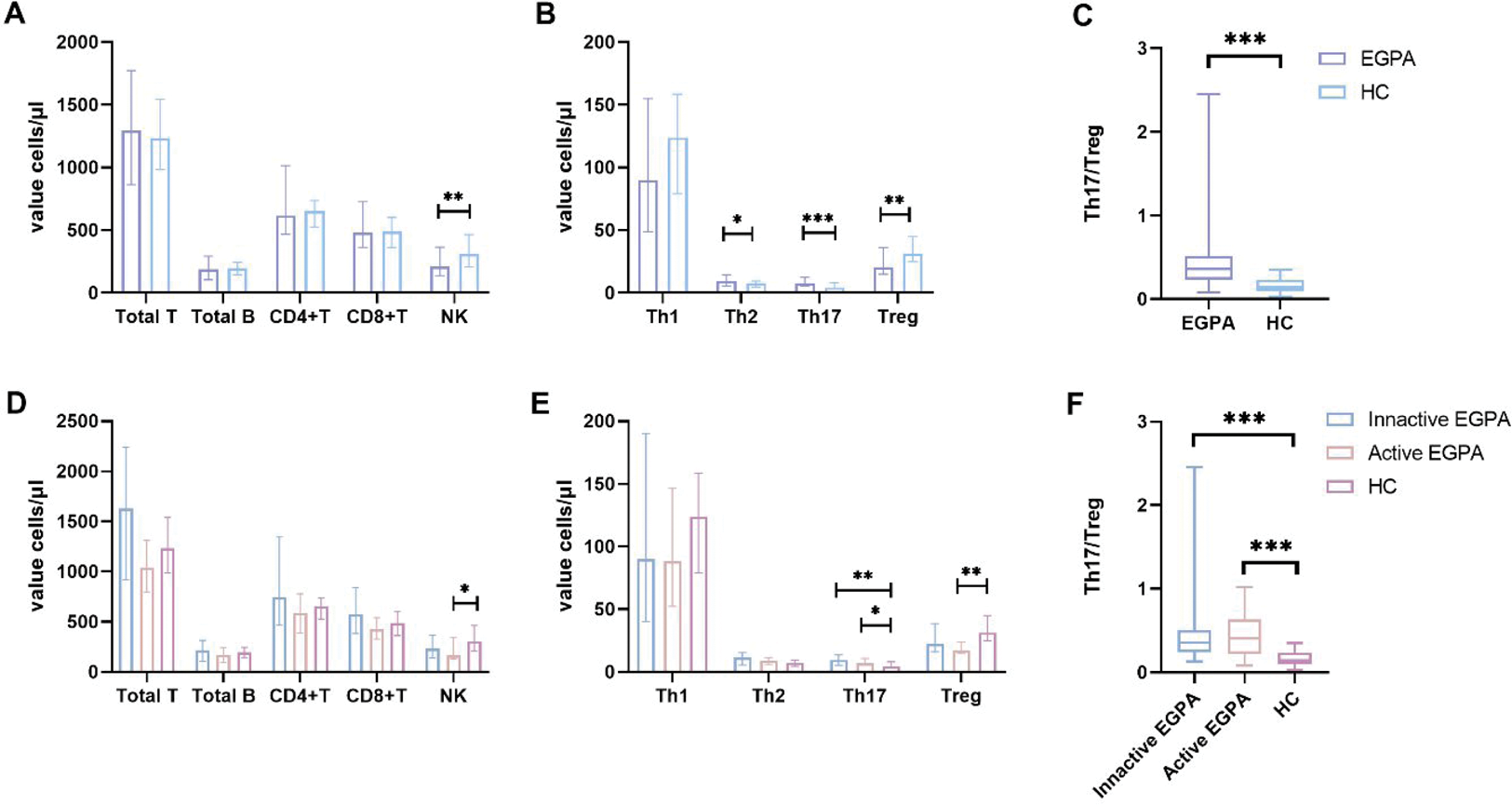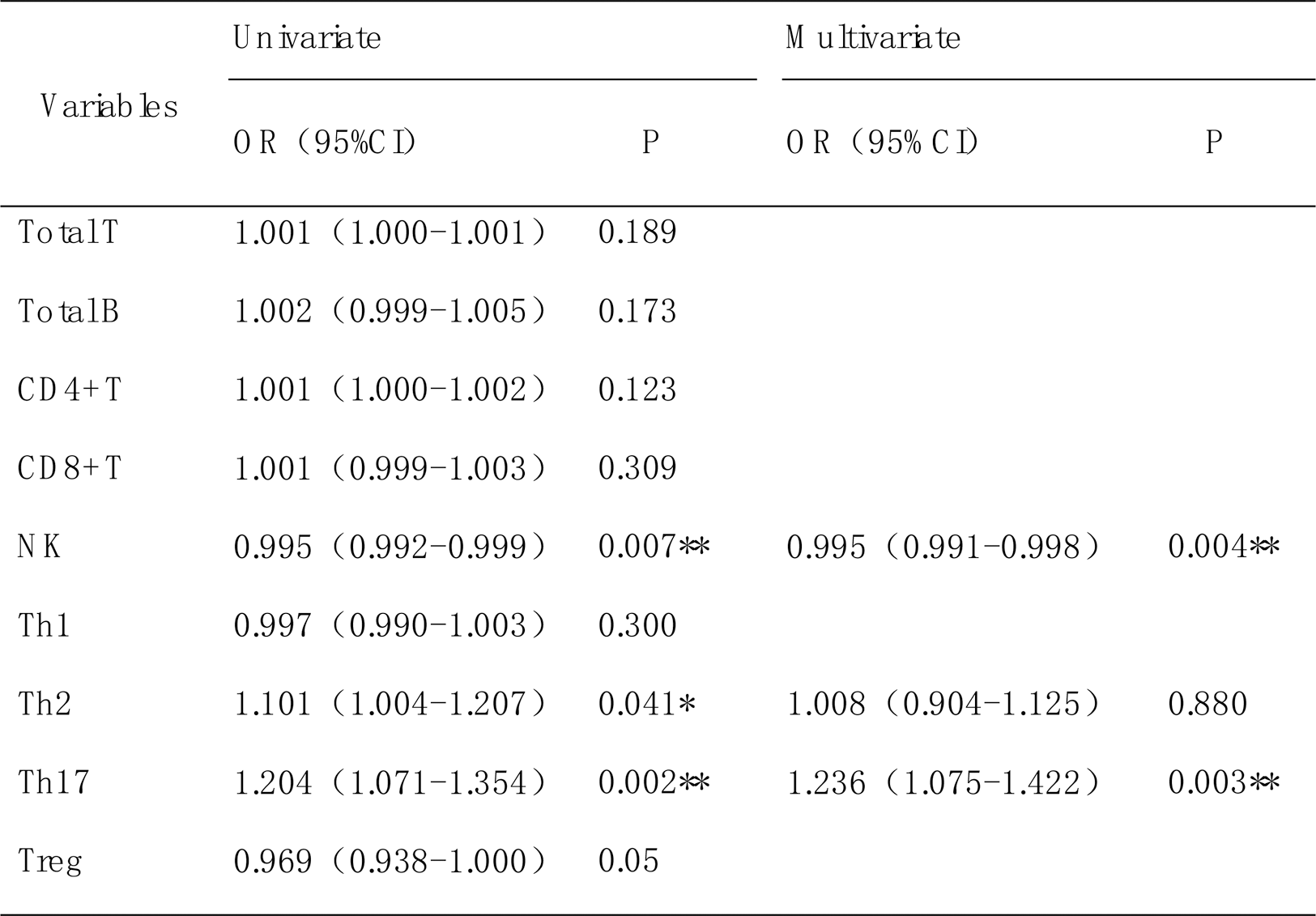

Background: Recent Studies have shown that the imbalance between Th17 cells and regulatory T cells is involved in the development of AAV[1-4]. In AAV, an increase in the proportion of Th17 in the peripheral blood or a decrease in the proportion of Treg with altered Treg function were found, and the Treg ratio or immune activity can be restored after treatment [1,2,5,6]. Differences in immune function have been found in patients with EGPA with different disease activity states, particularly a decrease in absolute Treg cell counts [6]. However, the immune status of patients with EGPA and the presence of a Th17/Treg imbalance are unknown.
Objectives: In this study, the levels of peripheral blood lymphocyte subsets and CD4+ T cell subsets in patients with EGPA were compared with healthy controls, and in patients with inactive EGPA, active EGPA, and healthy controls. In addition, univariate combined with multivariate logistic analysis was performed to screen for possible risk factors for the onset of EGPA.
Methods: In this study, 45 healthy controls and 34 patients with EGPA were included, and 18 patients with inactive EGPA and 16 patients with active EGPA (BVAS score≥15) were divided according to the Birmingham Vasculitis Score (BVAS). Flow cytometry was used to detect the absolute number of peripheral blood lymphocyte subsets and CD4+ T cell subsets in each group.
Results: Compared with the healthy control group, the absolute value of natural killer cells (NK) in peripheral blood of EGPA patients was significantly decreased (P<0.01), the absolute value of helper T cell 2 (Th2) was increased (P<0.05), and more importantly, the absolute value of regulatory T cells (Treg) was significantly decreased (P<0.01), the absolute value of T helper cells 17 cells (Th17) (P<0.001) and the Th17/Treg ratio (P<0.001) were significantly increased.Further analysis found that the decrease in Treg cells in EGPA patients was mainly present in patients with active EGPA.Univariate combined with multivariate logistic analysis confirmed that Th17 was an independent risk factor for the occurrence of EGPA.
Conclusion: Our study clearly shows that there is an immune imbalance in EGPA patients, especially the most significant increase in Th17/ Treg ratio. Detection and balance of lymphocytes and CD4+ T subsets, particularly Treg and Th17 subsets, may help correct immune disorders. Of course, the immune function of patients with EGPA with different levels of disease activity is not completely consistent, at least when it comes to immune cells.
REFERENCES: [1] Abdulahad WH, Stegeman CA, Limburg PC, Kallenberg CG. Skewed distribution of Th17 lymphocytes in patients with Wegener’s granulomatosis in remission. Arthritis Rheum. 2008;58(7):2196-2205.
[2] Tsurikisawa N, Saito H, Oshikata C, Tsuburai T, Akiyama K. Decreases in the numbers of peripheral blood regulatory T cells, and increases in the levels of memory and activated B cells, in patients with active eosinophilic granulomatosis and polyangiitis. J Clin Immunol. 2013;33(5):965-976.
[3] Kerstein A, Schuler S, Cabral-Marques O, et al. Environmental factor and inflammation-driven alteration of the total peripheral T-cell compartment in granulomatosis with polyangiitis. J Autoimmun. 2017;78:79-91.
[4] Jennette JC, Falk RJ, Hu P, Xiao H. Pathogenesis of antineutrophil cytoplasmic autoantibody-associated small-vessel vasculitis. Annu Rev Pathol. 2013;8:139-160.
[5] Mirouse A, Cacoub P, Saadoun D. Regulatory T cells and systemic vasculitis. Curr Opin Rheumatol. 2023;35(1):25-30.
[6] Wu R, Mu Y, Zhao X, et al. Short-term and low-dose IL-2 therapy increases the reduced Treg cells in patients with microscopic polyangiitis. Autoimmun Rev. 2022;21(9):103156.
Comparison of lymphocyte absolute values and CD4+ T cell subsets. (A-C) is the difference in the lymphocyte absolute values and CD4+ T cell subsets between EGPA patients and healthy controls. (D-F) is the difference in lymphocyte absolute values and CD4+ T cell subsets between patients with inactive EGPA, patients with active EGPA, and healthy controls.

Table 1. Univariate combined multivariate logistic analysis of EGPA occurrence and absolute lymphocyte and CD4+ T cell subsets.

REFERENCES: NIL.
Acknowledgements: NIL.
Disclosure of Interests: None declared.